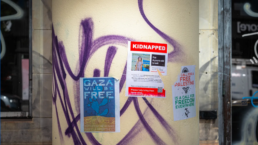The pause in the fighting in Gaza — with some humanitarian aid allowed in and exchange of some Israeli and Palestinian captives — is important, but not nearly enough. We need to fight for a permanent ceasefire.
by Khury Petersen-Smith and Phyllis Bennis, Foreign Policy in Focus
In the current deal between Israel and Hamas — brokered by Qatar, Egypt, and the United States — all parties agree to stop fighting for four days. Hamas will release 50 women and children it took captive on October 7, and Israel will release 150 women and children who are among the 10,000 or so Palestinians it holds in Israeli military prisons.
There is the possibility of extending the pause — and exchanging more captives — for up to five more days after the initial agreement is implemented, potentially leading to a pause of as many as nine days.

The most obvious significance of this deal is humanitarian. Captives will be freed from Gaza and from Israel, and Israel’s massive bombardment of Gaza will pause, as will Palestinian fighters’ firing of rockets into Israel. Desperately needed humanitarian aid convoys and fuel will be allowed into Gaza.
This is also important because it proves that diplomacy can work.
Ending the continuing deaths under Israeli bombs, and securing the release of captives is happening not because of fighting, but because of negotiations. And that means more diplomacy can work too — perhaps leading to a full ceasefire, an exchange of all captives, full humanitarian access into Gaza, and ultimately an end to the siege of the Gaza Strip.
Recent Posts
The Rage Of Billionaires And The Frenzy To Stop Zohran Mamdani From Becoming New York’s Mayor
June 30, 2025
Take Action Now The constellation of forces now regrouping with a vengeance includes titans of Wall Street, enormous real estate interests,…
It’s Not Just The Cities. Extreme Heat Is A Growing Threat To Rural America.
June 28, 2025
Take Action Now The urban heat island sits in a rural heat ocean.By Umair Irfan, Vox Summer has officially begun with a blast of scorching…
Mamdani’s Massive Victory Should Show Democrats Where The Party’s Future Lies
June 27, 2025
Take Action Now NYC mayoral candidate Zohran Mamdani has thrown the drowning Democratic Party a life vest. Will its leaders use it?By Sam…
India Walton’s Advice For Zohran Mamdani
June 26, 2025
Take Action Now “I think that for him, the race ’til November needs to be staying on message—we can’t start to water it down…




